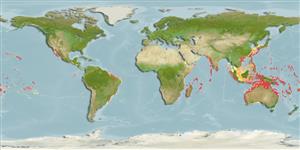Bivalvia |
Pectinida |
Pectinidae
Environment: milieu / climate zone / depth range / distribution range
Ecology
Benthic; depth range 0 - 82 m (Ref. 89006). Tropical
Atlantic, Indian, and Pacific Ocean.
Length at first maturity / Size / Weight / Age
Maturity: Lm ? range ? - ? cm
Dead specimens washed up on beaches, and to 30 m (Ref. 377). Occurs on soft sediments, coral rubble, sand, rocky shores, and tidal pools at intertidal depths. Also on slabs of coral limestone and scattered reefs (Ref. 87907). Living at depths intertidally to 24 m (Ref. 89006). Single valves found on the beaches (Ref. 88739).
Life cycle and mating behavior
Maturity | Reproduction | Spawning | Eggs | Fecundity | Larvae
Members of the class Bivalvia are mostly gonochoric, some are protandric hermaphrodites. Life cycle: Embryos develop into free-swimming trocophore larvae, succeeded by the bivalve veliger, resembling a miniature clam.
Werner, T.B. and G.R. Allen 2000 A rapid marine biodiversity assessment of the Calamianes Islands, Palawan province, Philippines. RAP Bulletin of Biological Assessment 17. Washington, D.C.:Conservation International. (Ref. 8295)
IUCN Red List Status
(Ref. 130435: Version 2025-1)
CITES status (Ref. 108899)
Not Evaluated
Not Evaluated
Threat to humans
Harmless
Human uses
| FishSource |
Tools
More information
Trophic EcologyFood items (preys)
Diet composition
Food consumption
Predators
Population dynamicsGrowth
Max. ages / sizes
Length-weight rel.
Length-length rel.
Length-frequencies
Mass conversion
Abundance
Life cycleReproductionMaturityFecunditySpawningEggsEgg developmentLarvae PhysiologyOxygen consumption
Human RelatedStamps, coins, misc.
Internet sources
Estimates based on models
Preferred temperature
(Ref.
115969): 17.6 - 28.8, mean 27 (based on 1406 cells).
